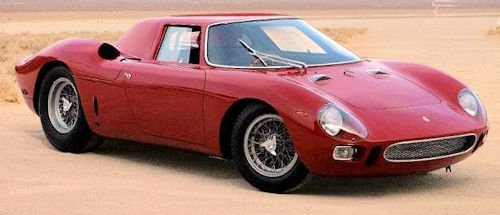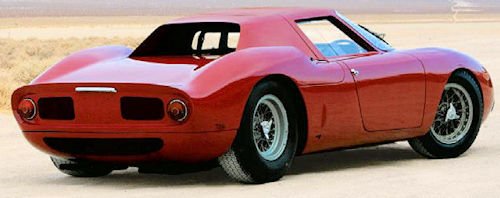Ferrari 250 LM
| 1963 to 1964 | |
|---|---|
 |
|
| Builder | Ferrari |
| main type | coupe |
| Production | from 1963 to 1964 |
| Units produced | 33 |
| Length | 4,090 m m |
| Width | 1,700 mm |
| Height | 1,115 mm |
| Passage | 2,400 mm |
| Mass | 850 k g |
| Project | Giotto Bizzarrini |
| Style | Sergio Scaglietti |
The Ferrari 250 LM is a road car built by Italian manufacturer Ferrari during the sixties.
History
The Ferrari 250 LM It is often mistakenly called Ferrari 275 LM because of engine capacity of 3.3 liters . It was used actively in competitions and participated in the World Sportscar Championship.
In 1963 Ferrari introduced the Motor Show in Paris what was to be the heir of the 250 GTO , the 250 LM. Derived from the prototype 250 P , LM was going to Le Mans, indicating that the car was destined to participate in the French endurance race. In total there were produced 33 pieces, but the FIA not ritenette enough (figure had increased to 100) and not conceded, the ' approval in the category Gran Turismo , so the 250 LM had to contend with prototypes . Nevertheless he managed to bring several important statements. But as a result of the non-homologation of Enzo Ferrari in protest deployed in the last Grand Prix of the Formula 1 season 1964, its cars entrusted to John Surtees (then win the world championship) and Lorenzo Bandini with white and blue colors of the North American Racing Team, the NART, it owned Luigi Chinetti, Ferrari importer for North America.
The 250 P evolved into a saleable mid-engined racer for the public, the 250 Le Mans. Introduced at Paris in November, 1963, the LM was successful for privately entered racers around the world. Notably, a 250 LM entered by the North American Racing Team won the 1965 24 Hours of Le Mans driven by Jochen Rindt and Masten Gregory, which remains as Ferrari's last overall victory in the endurance classic. This car also is on display at the Indianapolis Motor Speedway Hall of Fame Museum. About 32 models were built in 1964 and 1965, with all but the first few powered by 3.3 L 320 hp (238 kW) engines, though the name did not change with the increase in displacement. A fully independent double wishbone suspension was specified with rack and pinion steering and four wheel disc brakes. Ferrari had intended that the 250 LM be homologated for racing as a Group 3 Grand Touring Car, however in April 1964 the FIA refused to do so as Ferrari had built considerably fewer than the required 100 units. The 250 LM thus had to run as a Prototype until it was homologated as a Group 4 Sports Car for the 1966 season.
The North American Racing Team Ferrari 250 LM that won the 1965 24 Hours of Le Mans is a popular attraction at classic car shows and was on display recently at the 2013 Amelia Island Concours d'Elegance. A 1964 Ferrari 250 LM was auctioned off by Sotheby's in 2013 for a price of $14.3 million to an undisclosed telephone bidder. This bidding smashed the previous price record for this model.
Berlinetta Speciale

In 1965 , the year of the victory of 250 LM at Le Mans, Pininfarina prepared a special version of this car. The 250 LM Berlinetta Speciale, so it was called, was presented at the Motor Show Geneva the same year. The main differences were the large rear window in plexiglas , covering the engine compartment instead of the existing rear cover plate, the vents on the rear wheel arches, which were covered by a grille and the addition of small beaks bumper chrome . The car adopted the livery of the team NART , a white with a blue stripe.
Specifications
The 250 LM presented at the Paris Motor Show featured a V12 from 2953.2 cc of displacement , the same used by the 250 GTO and the Red Head . But in the following examples the displacement was increased to 3285.7 cm³, so that some sources erroneously reported his name as 275 Le Mans , following the traditional code designations berlinetta Ferrari. The power was entrusted to 6 carburetors 38DCN of Weber with 2 electric pumps. The engine was mounted longitudinally and centrally located, and the exchange , 5-speed, was also longitudinal and cantilever mounted behind the engine itself. The power was 320 hp .
PERFORMANCE: 3.3L
- Engine capacity: 200.49 cu in, 3,285.722 cu cm
- Fuel consumption: 12.8 m/imp gal, 10.7 m/US gal, 22 1 x 100 km
- Power-weight ratio: 6 lb/hp, 2.7 kg/h
- Max power (DIN): 320 hp at 7,500 rpm
- Max torque (DIN): 232 1b ft, 32 kg m at 5,500 rpm
- Max number of engine rpm: 7,500
- Specific power: 97.4 hp/l
- Max speed: 180.1 mph, 290 km/h
- Max speeds: 80.8 mph, 130 km/h in 1st gear; 114.3 mph, 184km/h in 2nd gear; 142.2 mph, 229 km/h in 3rd gear; 161.5 mph, 260 km/h in 4th gear; 180.1 mph, 290 km/h in 5th gear
The frame was trellis tube steel . The suspensions , or front the rear, were double wishbone with independent wheels, the shock absorbers were hydraulic with spring coil.
As already mentioned, the racing career of the Ferrari 250 LM was affected by the non-approval of the Gran Turismo , so the car was registered in Class Prototypes coaches over 3.0 liters (only the car with the chassis no. 5149 of NART, with the engine 3 liter, was recorded under Prototypes coaches within 3.0 liters ), going to confront cars specifically designed for competitions, such as the Ferrari 250 P (and their derivatives), theMaserati Tipo 151 and the Iso Grifo A3C , as well as with other GT not yet approved, such as the Ford GT40 .
Despite this he obtained the first and second place at the 12 Hours of Reims of 1964 and the 24 Hours of Le Mans of 1965 (latest success of Ferrari in the French marathon), the same year won the 500 km of Spa and in ' following year won the 1000 km of Paris . The 24 Hours of Le Mans and the 1966 five 250 LM finished among the top 10, but neither took the podium. The car won the last race in 1967 .
The 250 LM this found a lot of success among the private teams, and even the two cars that won the 24 Hours of Le Mans belonged both to private teams, precisely that came first to the American team NART and that finished second at the Francorchamps Belgian team.
Achievements
- July 5, 1964: 12 Hours of Reims ; Hill / Bonnier
- September 13, 1964: 500 miles of Elkhart Lake ; Hansgen / Pabst
- 31 October 1964: 9 Hours Rand ( Circuit Kyalami ); Piper / Tony Maggs
- May 16, 1965: 500 km of Spa , Willy Mairesse
- June 7, 1965: 6 Hours of Perth; Spencer Martin
- 19 to 20 June 1965 24 Hours of Le Mans ; Rindt / Gregory / Hugus
- October 16, 1966: 1,000 km of Paris; Piper / Parkes
Technical
-
Ferrari 250 LM Technical details and specifications (1963-1964)
ENGINE
rear, longitudinal center
4 stroke; cylinders: 12, Vee-slanted at 60°
bore and stroke: 3.03 x2.31 in, 77 X 58.8 mm
engine capacity: 200.49 cu in, 3,285.722 cu cm
compression ratio: 9.7
cylinder block: light alloy, wet liners
cylinder head: light alloy, hemispherical combustion chambers
crankshafts bearings: 7
valves: 2 per cylinder, overhead, Vee-slanted. roller rockers
camshafts: 2, overhead
lubrication: 2 gear pumps, filter on by-pass, dry sump, oil coolercarburation: 6 38DCN Weber downdraught twin barrel carburettors
fuel feed:2 electric pumps
cooling system: water
TRANSMISSION
driving wheels: rear
clutch: single dry plate
gearbox: mechanical; gears: 5 + reverse
synchromesh gears: none
gearbox ratios: I 2.214, II 1.555, III 1.250, IV 1,105, V 1, rev 1.467
gear lever: central; final drive: spiral bevel,limited slip
axle ratio: 3.182.CHASSIS
tubular, trellis
front suspension: independent, wishbones, coil springs,anti-roll bar, telescopic dampers
rear suspension: independent, wishbones, coil springs, anti-roll bar, telescopic dampers.STEERING
rack-and-pinion.
turning circle (between walls): 43.9 ft, 13.4 mBRAKES
disc. front: a disc / rear: DiscELECTRICAL EQUIPMENT
voltage: 12 V
battery: 50 Ah
alternator: 40 Ah
ignition distributors: 2 MarelliDIMENSIONS AND WEIGHT
wheel base: 94.49 in, 2,400 mm
front track: 53.15 in, 1,350 mm
rear track: 52.76 in, 1,340 mm
overall length: 157.83 in, 4,009 mm
overall width: 66.93 in, 1,700 mm
overall height: 43.90 in, 1,115 mm
ground clearance: 4.72 in, 120 mm
dry weight: 1,874 1b, 850 kg© Motor car History
Service
-
Ferrari 250 LM Maintenance and Service Guide (1963-1964)
Fuel: 98-100 oct petrol
Engine sump oil: 28.16 imp pt, 33.82 US pt, 16 1, SAE 20 (winter) 40 (summer)
Total lubricating system capacity: 29.92 imp pt, 35.94 US pt
Gearbox and final drive oil:Ricinax Super-heavy oil
Cooling system capacity: 21.12 imp pt,25.37 US pt, 12 1.
Tappet clearances: inlet 0.006 in, 0.15 mm, exhaust 0.008 in, 0.20 mm.
Tyres: 5.50 x 15 front, 7.00 x 15 rear
Fuel tank capacity: 28.6 imp gal,34.3 US gal
Carrying capacity: 353 1b, 160 kg© Motor car History

